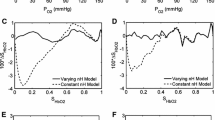Abstract
Evaluation of blood oxygenators using whole blood is inconvenient and expensive, although it is the ultimate preclinical test. Sodium sulfite solutions have advantages over blood for studying oxygen uptake: They are inexpensive, fewer variables need control, and deoxygenation is unnecessary. Assays and interpretation of results are easy. The kinetics of sulfite oxidation must be fast and the concentration of sulfite must be low to emulate oxygen uptake by blood. The kinetics were studied yielding a first order rate constant in sulfite, zero order in oxygen, of 740/min. Limitations of the technique were evaluated using the experimental rate constant and an adaptation of Lightfoot’s approximation. While the reaction of hemoglobin is reversible and essentially instantaneous, that for sulfite is irreversible and finite. Thus if the approach to saturation is not monotonic or if the mass transfer resistance is significantly lowered, e.g., when blood film thicknesses are thinner than a few hundred microns, deviations may occur. Two TMO oxygenators and several prototypes were tested, with both sulfite and bovine blood. Uptakes of oxygen were comparable and the effect of parameter variations were similar. The use of sulfite for early evaluation of oxygenators is concluded to be very useful.
Similar content being viewed by others
References
Astarita, G., G. Marrucci, and L. Coleti. Ossidazione catalitica del solfito di sodio: Un metodo per la misura di aree interfaciali.Chim. Ind. M. 46: 1021–1026, 1964.
Ayres, G.H.Quantitative Chemical Analysis. New York: Harper & Row, 1958, pp. 409–628.
Barron, C.H. and H.A. O’Hern. Reaction kinetics of sodium sulfate oxidation by the rapid-mixing method.Chem. Eng. Sci. 21: 397–404, 1966.
Bird, R.B., W.E. Stewart, and E.N. Lightfoot,Transport Phenomena. New York and London: John Wiley and Sons, 1960, pp. 532–533.
Cooper, C.M., G.A. Fernstrom, and S.A. Miller. Gas-liquid contactors.Ind. Eng. Chem. 36: 504–509, 1944.
Danckwerts, P.V.Gas Liquid Reactions. New York: McGraw-Hill Book Co., 1970, pp. 254–255.
Eberhart, R.C. and R.M. Curtis. The effect of solid and hollow screens on gas exchange in membrane oxygenators.Trans. Am. Soc. Artif. Intern. Organs 19: 66, 1973.
Eberhart, R.C., S.K. Dengle, and R.M. Curtis. Mathematical and experimental methods for design and evaluation of membrane oxygenators.Artif. Organs 2: 19–34, 1978.
Fuller, E.C. and R.H. Crist. The rate of oxidation of sulfite ions by oxygen.J. Am. Chem. Soc. 63: 1644, 1941.
Galletti, P.M., P.D. Richardson, and M.T. Snider. Blood oxygenator testing and evaluation. Evaluation Techniques, Report NIH-69-2047-1, Artificial Heart Program, NHLI, 1971.
Greene, G.C. Oxygenation of sodium sulfite and blood. Master’s thesis. Columbia University, New York, 1968.
Kaufmann, T.G. and E.F. Leonard. Mechanism of interfacial mass transfer in membrane transport.AIChE J. 14: 421–426, 1968.
Kayser, K.L. Blood gas interface oxygenators versus membrane oxygenators: What are the proved differences.Ann. Thorac. Surg. 17: 459, 1974.
Keller, K.H. and K.L. Shultis. Oxygen permeability in ultrathin and microporous membranes during gas-liquid transfer.Trans. Am. Artif. Intern. Organs 25: 469–472, 1979.
Lightfoot, E.N. Low order approximations for membrane blood oxygenators.AIChE J. 14: 669, 1968.
Linek, V. and J. Tvrdik. A generalization of kinetic data on sulfate oxidation systems.Biotechnol Bioeng. 13: 353–369, 1971.
Shah, S.S. Bloodless evaluation of blood oxygenators. Master’s thesis. Columbia University, New York, 1980.
Stroeve, P. and R. Srinivasan. An approximate solution for the graetz and leveque problems for the advancing front theory.AIChE J. 26: 136–139, 1980.
Travenol Laboratories. Direction sheet accompanying TMO adult membrane oxygenator, 1973.
Author information
Authors and Affiliations
Rights and permissions
About this article
Cite this article
Shah, S.S., Leonard, E.F. Bloodless evaluation of blood oxygenators. Ann Biomed Eng 11, 67–81 (1983). https://doi.org/10.1007/BF02367492
Issue Date:
DOI: https://doi.org/10.1007/BF02367492




